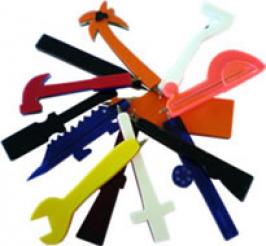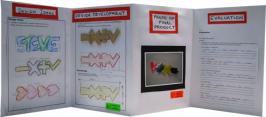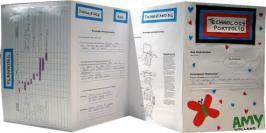Personalised pen – Unit plan
Overview

Year 7 Materials
- Context: Writing tools
- Key focus: Materials
Class description/Students past experiences:
Year 7 students. No experience in the technology rooms. Little understanding of technological practice.
Resources required:
- 3mm Acrylic, card, masking tape, coping saws, scroll saws, ink refills
Safety considerations
Refer to Safety in technology education: A guidance manual for New Zealand schools (April 2017)
- Safe use of hand tools
- Use of scroll saws
Curriculum links
| Key focus: (Technological practice)
| Context specific skill/knowledge:
|
| Key competencies
| Values
|
Cross curriculum links
- Maths – measuring
- Problem solving
- English – evaluative skills
Learning outcomes and assessment
Predetermined specific learning outcomes
Students:
- develop skills in working with plastics
- develop knowledge of plastic performance
- develop 2D sketching and rendering techniques
- develop an understanding of the Key stages in the technology cycle (CoT)
- undertake own time management to ensure the completion of a quality outcome (PfP)
- undertake modelling as a form of testing and trialling (ODE and TM)
- apply knowledge and skills in the manufacture of a quality solution (ODE).
Assessment strategies
- Observation of tool selection and use to produce an outcome.
- Discussion with students about knowledge of how to work materials to form products.
- Teacher checks through ongoing formative discussions with each student and marking of portfolios to ensure all students have: developed concepts, tested mock-ups, completed an outcome in given time, evaluated outcome against performance specs.
- Observation of cooperation between students.
Assessment (45kb) – This Word doc contains student self-assessment and teacher assessment rubrics.
Lesson outline
Worksheets (71kb) – Download this Word doc for students to work through the design process.
Lesson 1
| Lesson sequence | Resources | Learning intentions |
| Introduction into course Roll and bench seating plan Intro to the workshop:
| ||
| Codes of practice – Safety in the environment of practice
| Students:
|
|
| Introduce technology cycle
| Student module booklet:
| Students can:
|
| Technological knowledge Introduce students to plastics:
| ||
| Skills development Key stages – teach skills, (related to knowledge and understanding in brief.)
The teacher demonstrates use of tools, i.e. use of rulers, measuring, metric system and how to measure a rectangle 65mm x 35mm onto a piece of card. Draw two rectangles then demonstrate how to draw a random design and a symmetrical design. Cut out the shapes. Students choose two pieces of acrylic and the teacher glues them together. The students then mark out their shape onto one of the surfaces of the acrylic. The teacher then explains and demonstrates why we drill the hole for the split ring first, before cutting out the shape. Explain why waste wood is placed behind the acrylic when drilling the hole. The students then proceed to drill the hole. | Workshop equipment and processes:
Knowledge and understanding
|
|
Lesson 2
| Lesson sequence | Resources | Learning intentions |
| Students go to assigned benches and the roll is called. The teacher then recaps on the last lesson. Then introduces the hand tools and machine tools that are appropriate to cut out the shape. The coping saw and scroll saw – the teacher demonstrates the use of both tools as a method of cutting out the shapes keeping to the waste side of the line. Codes of practice, i.e. safety in practice with the use of tools and machines. Correct working procedures to gain desired outcome. Once the shape is cut out the teacher demonstrates how to file down to the line using a range of files:
| Students:
|
|
| Demonstrate how to round the edge using the fine file. The teacher then demonstrates how to sand the edges smooth using three grades of paper progressively getting the edges smoother.
The teacher then demonstrates how to polish the edges using Jif and a rag. | ||
| Refer to the class brief Ask the students to choose a key stakeholder – someone to design the pen for (usually a family member). | Student module booklet
| Students:
|
Lessons 3 – 7
| Lesson sequence | Resources | Learning intentions |
| Technology cycle | ||
| Introduction to issue Revise the technology cycle. Introduce the issue of pens and the use of these as promotional material and the fact that they come in all shapes and sizes. Introduce class brief and discuss attributes/specifications. | Technology cycle flow chart. Examples of required stationary. Year 9 teachers handbook | Students understand the:
|
| Reflect on key stakeholder and stakeholder interests / hobbies / likes / dislikes. Complete the first page in their brief (this can be completed for homework if not done in class)
| ||
| Talk about restrictions and the importance of planning to make sure their pen is finished in time and to a high standard. Talk about the key stages and the time available (6 sessions)
| Worksheets. | Students understand:
|
| Concepts: Develop ideas for possible pen designs. Teach students about 2D sketches and the use of Design ideas. Use the work sheet. Draw concepts that meet stakeholder interests. Apply annotations to support ideas.(Design ideas must fit into the drawn rectangle.) | Worksheet Drawing equipment Colouring pencils | Students:
|
| Mock up / Model: Use mock-up to test design ideas and to make modifications to the product. (scale 1:1) Use the mock-ups as a template. Development: Use the model as a template to make modifications. Apply the feedback given to you by the stakeholder. Make any adjustments requested and show this on the development worksheet. Support changes / modifications with annotations. | Drawing equipment Card, scissors, rulers 3mm mdf Scrollsaws Worksheets | Students:
|
| Final brief: Create a final written statement that explains:
| Worksheet | Students understand the importance of a final brief |
| Working drawing: Teach 2D drawings – Elevations and how to apply dimensions. | Worksheets.Formal drawing and dimensions. | Students understand the importance of accuracy to create a quality outcome. |
| Manufacturing
|
Continuum of skills development learnt previously. | Students apply relevant knowledge and skills to manufacture an outcome. |
| Plastics theory
| Plastic hand-out Handout on finishing plastic Information on properties Worksheet | Students can identify the material they are working with and possible implications in using plastics. |
Lesson 8
| Lesson sequence | Resources | Learning intentions |
| Portfolio presentation and evaluation
| Evaluation sheet Assessment Rubric Portfolio card, craft knifes and cutting mats | |
| Demonstrate how to use the cutting mats and craft knifes to cut accurate rectangles to mount their photos and titles. Demonstrate how to glue their pages onto their portfolios. | Students take pride in their presentation of their work. |
Downloads
Worksheets (71kb) – Support students to work through the design process.
Assessment (45kb) – Student self-assessment and teacher assessment rubrics.


